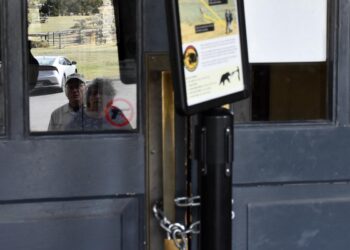By Jessianne Castle EBS Contributor
BIG SKY – Ongoing research in Yellowstone is revealing a curious relationship between a wolf’s coat color and its health. Preliminary studies with CRISPR technology—a tool for editing genomes—shows that something different is going on when a black wolf is exposed to canine distemper versus one that is gray.
Through a partnership with the University of California, Los Angeles, biologists from Yellowstone National Park developed cell cultures derived from skin swabs from the ears of wild Yellowstone wolves.
“This is the first time that cell lines [or cell cultures] have been developed and gone through such experimentation from a wild animal,” said park biologist Dan Stahler during the Biennial Scientific Conference on the Greater Yellowstone Ecosystem held at Big Sky Resort in mid-September. Stahler is the project leader for the Yellowstone Wolf Project.
By introducing canine distemper to the cell cultures, researchers are trying to learn how black- and gray-colored wolves respond to the disease, and though preliminary, results suggest the response could be unique to the coat color.
“The mechanism might be, for example, [that the coat color gene] impacts how bacteria or viruses are binding to cellular receptors,” Stahler said.
What got Stahler and others interested in this research in the first place was the realization that Yellowstone’s wolves, though they are all of the gray wolf species, are a largely balanced population of 50-percent black and 50-percent gray.
“In vertebrates, pigmentation is really critical for a lot of traits—camouflage, sexual selection, thermoregulation, and even behavioral physiology,” Stahler said. Knowing how important color is, the unusually balanced color population has set the stage for studies that explore the link between genetics, fitness and selection.
A wolf’s coat color is determined by at least three different genes. Following gene theory, in its most basic sense, each gene comes as a pair and in the case of wolf color, can either be a gene for gray or black color. The black gene is dominant, meaning that a wolf with both the gray and black genes, known as heterozygous, would look black.
Genetic tests indicate that the Yellowstone population is about 55 percent homozygous gray, where both coat-color genes express the gray color; 42 percent heterozygous black, where one gene is black and the other is gray, but the wolf looks black; and very few individuals are homozygous black, where both coat-color genes are black.
Stahler said these numbers aren’t random. “There seems to be strong selection for the heterozygote black and selection against the homozygote black.”
He added that a single gene can have multiple effects and one that alters color could also be altering other aspects of cellular function. Of the three genes determining wolf color, Stahler said the K-locus gene has been found to also impact beta defensins, which are proteins involved in the immune system.
Before conducting the cell line research, biologists looked at individual- and population-wide life history, pedigrees and genetics, which were compiled over the last two decades. What they found was striking.
“Our homozygous black wolves did very poorly in our population. Their survival rate was low, their recruitment rate was low,” Stahler said. “In contrast, the same colored individual, the same colored wolf [that is heterozygous black], has very strong reproductive success, survival rates and other vital rates that are slightly higher than homozygous gray.”
Biologists also found that in years following large canine distemper outbreaks, black wolves had a higher survival rate than gray wolves. Conversely, though, by studying years of reproductive history, they learned that gray females had a 25-percent greater litter survival than black females.
“What we speculate may be going on here, is that there are tradeoffs,” Stahler said. “There’s a cost associated with certain gene actions. Because of this beta defensin gene, which is also causing black coat color, we think there’s some link to the immune system and mounting an immune response that plays into energetics and reproduction versus survival.”
In addition to the cell line studies, the tradeoff between survival—or improved immunity—and energetics and reproduction has been further explored by Kira Cassidy, a research associate for the Yellowstone Wolf Project.
Cassidy looked at aggression in Yellowstone’s wolves, ultimately finding that gray wolves are more likely to chase off other wolves than black individuals are. Gray wolves also have higher cortisol levels, which act on aggression and stress response, suggesting that gray wolves are in fact more aggressive than black wolves.
Biologists hope that further analysis of observational data and additional cell line testing will further explain this relationship between coat color, survival and reproduction.













